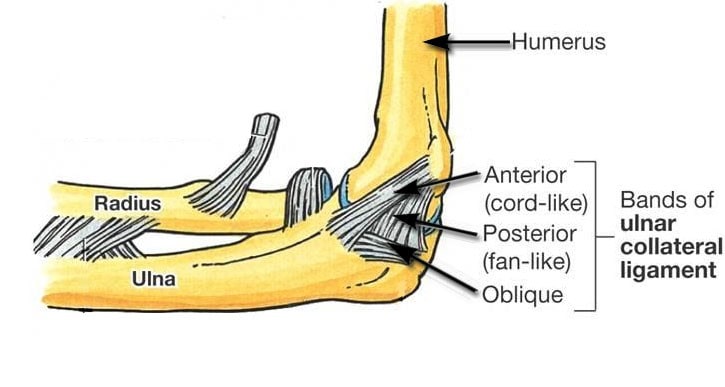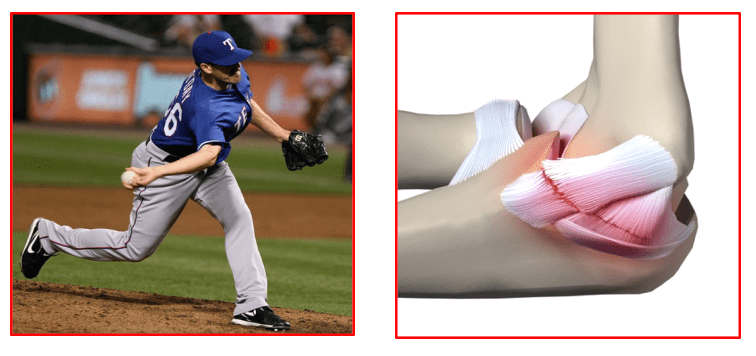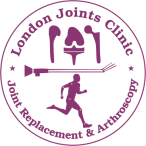Ulnar Collateral Injuries
of the Elbow
Ulnar collateral ligament (UCL), also called as the medial collateral ligament, is located on the inside of the elbow and connects the ulna bone to the humerus bone. It is one of the main stabilizing ligaments in the elbow especially with overhead activities such as throwing and pitching.

Ulnar collateral ligament (UCL) injury is usually caused by repetitive overhead throwing such as in baseball. The stress of repeated throwing on the elbow causes microscopic tissue tears and inflammation. With continued repetition, eventually the UCL can tear preventing the athlete from throwing with significant speed.
UCL injury may also occur due to direct trauma such as a fall, car accident, or work-related injury. Other causes include any activity that requires repetitive overhead motion of the arm such as tennis, pitching sports, fencing, and painting.
The common symptoms associated with an UCL injury are:
- Pain on inner side of the elbow,
- Unstable elbow joint,
- Numbness in the little finger or ring finger and
- Reduced performance in activities such as throwing baseballs or other objects.
Elbow UCL injury is diagnosed based on patient’s symptoms, thorough clinical examination and appropriate investigations like MRI scan.
The surgeon checks the alignment of the elbow, any tender areas and the range of motion. The UCL is stressed with a valgus or outwards stress to the elbow to reveal the extent of UCL injury and any elbow instability.
Tests like elbow X-rays and MRI scans may be requested to confirm the diagnosis.
UCL injuries can be managed conservatively or surgically.
All patients are generally recommended conservative treatment initially to treat the symptomatic UCL injuries.
Professional athletes, who wish to continue playing sports at a very high level, are offered surgery as first choice of treatment.
Conservative treatment options that are commonly recommended for routine patients include: activity restrictions, orthotics/splints, ice compression, anti-inflammatory medications, analgesic gels, elbow physiotherapy, pulsed ultrasound to increase the blood flow to the injured ligament and promote healing. Patients are also advised to get professional instructions to improve their sports specific techniques and avoid future injuries.
If conservative treatment methods fail to resolve the condition and patient’s symptoms persist beyond 6-12 months, surgery may be recommended for reconstruction of the ulnar collateral ligament.
UCL reconstruction surgery of the elbow repairs the UCL by reconstructing it with a tendon from the patient’s own body (autograft) or from a cadaver (allograft). The most frequently used grafts are the palmaris longus tendon from the patient’s forearm or the hamstring tendons from the knee.
The basic steps for UCL reconstruction surgery include the following:
- The surgery is performed in an operating room under regional or general anaesthesia on a pre-counselled and consented patient.
- An incision is made over the medial epicondyle area
- Care is taken to move muscles, tendons, and nerves out of the way. Extra care is taken to protect the ulnar nerve.
- The donor tendon is harvested from either the forearm or below the knee. The graft is cleaned and prepared
- Drills holes are made into the ulna and humerus bones at pre-determined areas.
- The donor tendon is then inserted through the drilled holes in a figure of 8 pattern
- The tendon is attached to the bone surfaces with special strong sutures
- The incision is closed with absorbable sutures and covered with sterile dressings. Sterile compression bandage is given.
- Finally, a special elbow range of motion splint is applied with the elbow flexed at 90 degrees.
- Patients are sent to the recovery room.
Patients are given appropriate guidelines for post-surgery rehabilitation depending on the type of repair performed and the surgeon’s preference.
Common post-operative guidelines include:
- Elevation of operated arm above heart level to reduce swelling and pain
- Wear an immobilizing splint for 1-3 weeks
- Apply ice packs to the surgical area 4-5 times to reduce swelling and pain
- Keep the surgical wound clean and dry. Cover the area with plastic wrap when bathing or showering.
- Physiotherapy is started early for strengthening and stretching exercises which help in regaining elbow mobility, improving muscle strength and giving better elbow function. Professional athletes can expect a strenuous strengthening and range of motion rehabilitation programme for 6-12 months before returning to their sport
- Eating a healthy diet and not smoking will promote healing
The majority of patients suffer from no complications following UCL reconstruction surgery. However, complications can occur following elbow surgery and include swelling, infection, stiffness or limited range of motion, nerve damage causing numbness, tingling, burning or loss of sensations in the hand and forearm area, cubital tunnel syndrome and elbow instability.
Book An Appointment
Private Clinics : Locations & Directions
London Joints Clinic (Pune)
Address
Office S 5, 2nd Floor, North Block, Sacred World Mall,
Opp Sacred Heart Township, Near Jagtap Chowk,
Wanawadi, Pune 411040
Monday to Saturday
6 PM to 9 PM
Appointments
Hospitals OPDs : Locations & Directions
Jupiter Hospital (Baner)

Address
Lane 3, Baner- Balewadi Road,
Prathamesh Park,
Baner, Pune 411 045
Monday to Saturday 11 AM to 4 PM
Appointments
Contact us
Dr Anand Jadhav has a centralised appointment system for all locations across various hospitals and clinics in Pune & PCMC areas
Appointment Bookings & Requests can be made by any method :

